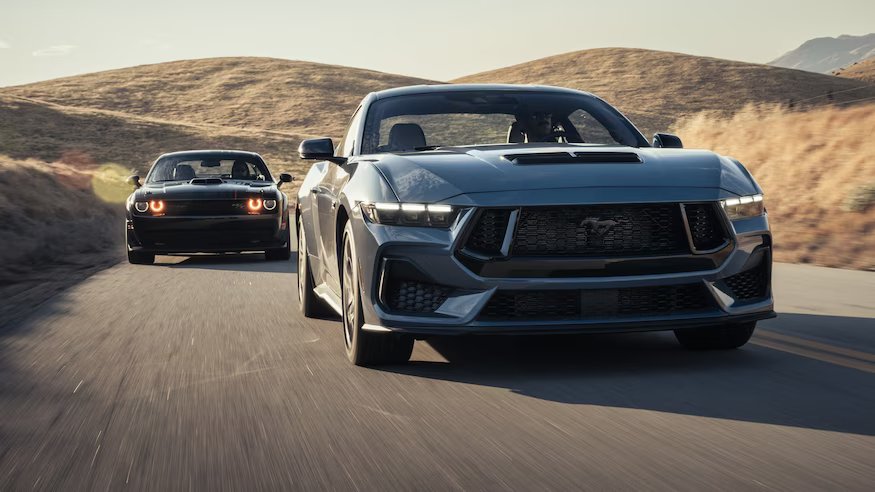Ford has emerged as the most steadfast in its commitment to its contender, the Mustang, having flirted with killing it long before it was cool. Rather than sacrificing its gas-powered icon for an EV, Ford expanded the Mustang family with the Mustang Mach-E electric SUV, taking things in a new direction without abandoning the old.
The 2024 Mustang GT Performance pack we have on hand, which is part of a new-for-2024 Mustang lineup, is more proof in the pudding and can be traced back to the original “1964 12” pony car.
The engine is a 5.0-liter V-8 with rear-wheel drive, a limited-slip differential, and a six-speed manual transmission.
The Dodge Challenger was always an afterthought. Historically not as popular as the Camaro or Mustang, the current generation flipped the script when it debuted in 2008 after a 25-year hiatus.
Much like the 1965 Mustang and 1967 Camaro, the 2008-2023 Challenger—particularly the monstrous 707-plus-horsepower Hellcat-powered variants offered since 2015—will be remembered fondly by enthusiasts.
But that doesn’t make the Challenger’s demise any easier to swallow. To its credit, Dodge has more concrete plans for the Challenger’s future; it and the Charger will most likely merge into a single fastback sedan, as hinted by the Charger Daytona SRT concept.
Engine
The Challenger Shakedown is a choice-spec widebody R/T Scat Pack T/A with a shaker hood (and supposedly not the act Dodge dealers will do to desperate customers).
It replaces the 375-hp 5.7-liter V-8 in the Challenger R/T with a 6.4-liter V-8 that produces 485 hp and 475 lb-ft of torque, then adds six-piston front and four-piston rear Brembo brakes, Bilstein electronically adjustable dampers, and Mopar cold air intakes that breathe through Hellcat-style “air catcher” headlights.
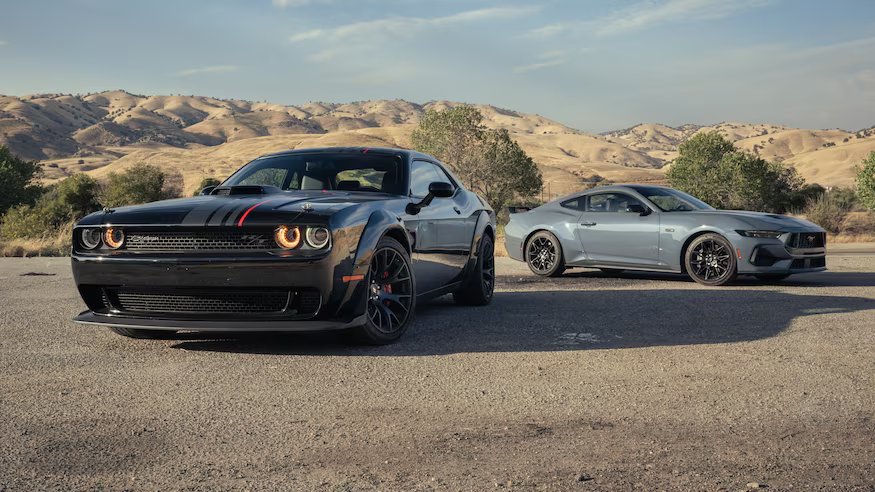
In addition to being inspired by a SEMA show car, the Shakedown adds vinyl stripes, hood pins, some unique badges, and an air of exclusivity to its 1,000-unit run. A six-speed manual is standard, but Dodge doesn’t keep six-speed manual Challengers in its fleet, so our R/T Scat Pack has an eight-speed automatic.
The total cost of our Challenger Shakedown was $68,800, which is roughly the same as the price of a similarly equipped non-Shakedown R/T Scat Pack Widebody from Dodge.
If you’ve been paying attention to Mustangs over the last decade, the new-for-2024 Mustang GT specs will probably feel familiar. This new model, a heavy reskin of the S550 model, is new enough to warrant the S650 code name.
The GT’s 5.0-liter V-8 now breathes through twin nostrils in the grille, combining with our test car’s active exhaust system to increase power to 486 hp, though torque drops 10 lb-ft to 418 lb-ft. It is paired with a Getrag six-speed manual transmission.
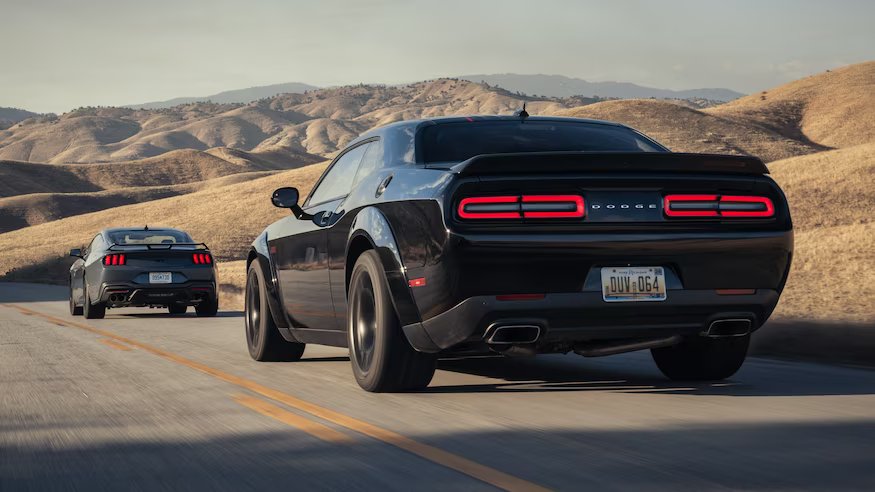
More effort was put into improving the steering (a new rack designed to improve front-end response), brakes (now by-wire), and chassis of the Mustang.
The $4,995 Performance pack ups the ante by including a Torsen limited-slip rear diff with a more aggressive 3.73:1 final drive, six-piston front and four-piston rear Brembo brakes, sticky summer tires, additional chassis bracing, and a few other extras. On top of the Performance pack, our car had the $1,750 optional MagneRide dampers. It has a sticker price of $61,775.
Performance
When it comes to muscle cars, bragging rights are everything, and it’s fair to say we had some expectations based on the specs. With 400 pounds more on the Mustang, the Porkier Dodge would almost certainly finish the quarter mile, staring at the Mustang’s new SN95-inspired taillights and ’67 Shelby Mustang lookalike rear end.
The Challenger happily proved us wrong, living up to the old hot rodders’ mantra of “no replacement for displacement.”

The big 392 Hemi-powered Dodge accelerated from 0 to 60 mph in 4.0 seconds and completed the quarter mile in 12.5 seconds at 112.1 mph. Meanwhile, the 307 Coyote-powered Mustang GT hit 60 mph in 4.3 seconds, matching the Challenger’s 12.5-second quarter-mile time but outperforming it at 114.7 mph.
To begin, despite the Mustang’s no-lift-shift feature, modern automatic transmissions are only slightly faster than humans shifting a manual transmission. Second, look into where the Coyote and Hemi get their power:
The Ford is a revver, with a horsepower peak of 7,250 rpm (just shy of its redline of 7,500 rpm) and a torque peak of 4,900 rpm. Meanwhile, the Dodge produces peak power at 6,100 rpm and 475 lb-ft of torque at 4,100 rpm. In other words, the Challenger develops more power faster than the Mustang, with the latter’s weight advantage becoming apparent only above 100 mph.
The Mustang also has an advantage when it comes to turning and stopping. Its best 60-0-mph stop was in 99 feet, while the Dodge managed a respectable but inconsistent 102-foot stop. The Mustang ran a 24.2-second lap at 0.80 g, while the Shakedown took 25.0 seconds at 0.76 g—close enough that we suspect a bad driver in a Mustang could be surprised by a good driver in a Challenger.
Comforts
Comparing the interiors of the two cars is like comparing two different eras in automotive history. The Challenger’s cabin was last updated in 2015, whereas the Mustang’s is completely new—a much quieter, more modern environment. However, newer does not always imply better.
The Ford is overly reliant on its twin dash displays—the left is the digital instrument cluster, and the right is the main infotainment display, which controls everything from the air conditioning and stereo to the Mustang’s active exhaust system.
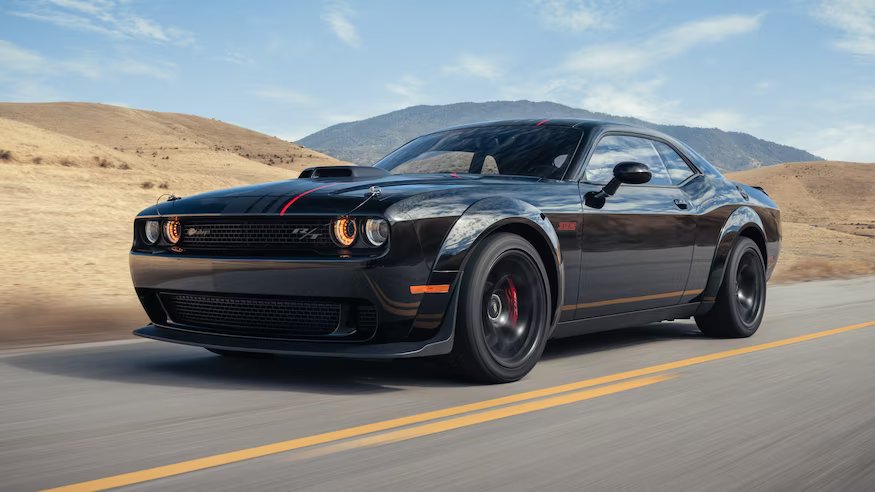
While these displays are crisp, clear, and simple to use, they take longer to boot up than the Challenger’s dated system—especially annoying when you’re roasting in a hot car and waiting for computers to turn on the A/C. The Dodge’s physical buttons and knobs have no such delay.
Ford also emphasizes the Mustang’s customizability. It is more customizable than the Challenger to some extent. Owners can select one of five instrument cluster displays and mix and match LED accents when properly equipped, but the Challenger is more meaningfully customizable.
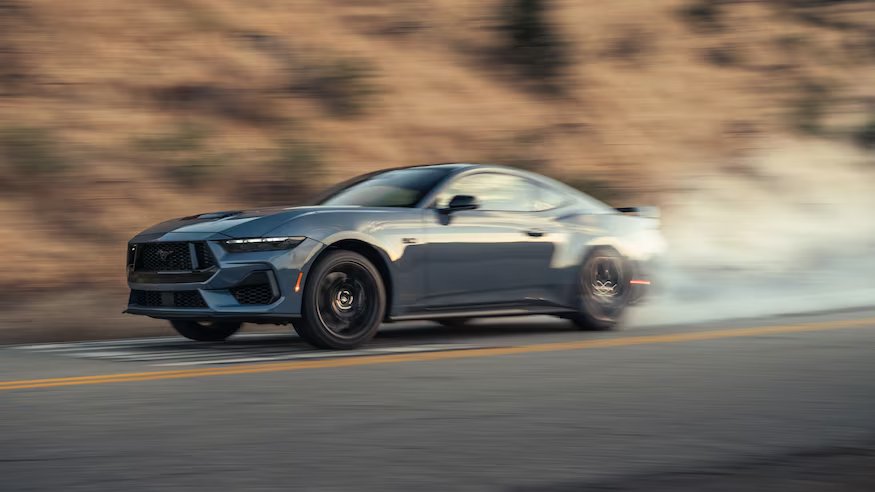
For example, both vehicles allow you to configure custom drive modes, but the Ford restricts your suspension, steering, and stability control settings to the powertrain setting (Normal, Sport, Track, or Slippery). The exhaust loudness level, gauge cluster, and color scheme are all up to you. That’s all. Dodge, on the other hand, is happy to let you configure a custom drive mode.
Conclusion
Despite competing for generations, the Ford Mustang and Dodge Challenger are vastly different vehicles. The Dodge is a throwback to a bygone era.
It proudly represents not only yesterday’s Dodge Charger and Challenger, but also the Pontiac GTO, Chevrolet Chevelle, Ford Fairlane, and all the other fallen greats. It makes you want to roll down the windows, blast Aerosmith’s live cover of “Train Kept A Rollin'” on the (horrible) stereo, and savor the fleeting moment.
The Mustang GT, on the other hand, feels like a product of the twenty-first century—modern, technologically advanced, yet delightfully anachronistic in its powertrain selection, given that the rest of its current competition uses turbocharged four- and six-cylinder engines.
Although it appears to be torn between the muscle and sports car camps, it is the last car standing for the time being. And, thankfully, it’s one we enjoy driving more.

